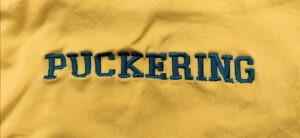 In this month’s article, Jas Purba, managing director of ETC Supplies, provides some top advice on embroidering shirts and blouses.
In this month’s article, Jas Purba, managing director of ETC Supplies, provides some top advice on embroidering shirts and blouses.
The first thing I see on someone wearing an embroidered shirt or blouse is the puckering around the embroidery.
During Printwear & Promotion LIVE! in April, I noticed this on the shirts of visitors of large embroidery companies and even some machine sellers. To me it was a ‘put off’ from using embroidery on such clothing. Many embroidery companies just let these garments go out without a second thought.
It is not easy. Shirts and blouses are manufactured from thin polyester or poly/ cotton fabrics. These fabrics have no resistance to needle and thread penetration so the crumple and pucker. You cannot just frame up a shirt and expect it to embroider the same as a sweatshirt. Embroidery on shirts and blouses, takes more time and effort, so it should be priced accordingly. Just remember, the embroidery may look ok when you have completed it, but how does it look after the first wash?
So here are a few points to look at.
- Is your digitising correct for this type of fabric? Do you have more underlay stitches than normal?
- Is your thread tension correct? Use a lower tension to stop stretching the thread, this causes puckering. Make sure you have one third under thread showing.
- Check your bobbins tension. This should be around 25g and adjust your top thread accordingly.
- Use the thinner needle with a smaller ball point. Something like a 65 SES would be advisable.
- Use the correct type of embroidery backing. A fusible is best for these garments.
- Check, is your garment fabric pre-shrunk?
So, let’s look at the embroidery backing in this article. Most embroidery on woven shirts and blouses should be done using a fusible backing. This will become part of the fabric and hence stabilise the design. You have several options as to what type of fusible backing to use.
Make sure the fusible backing is applied slightly larger than the size of the embroidery, and this will prevent the puckering around the embroidery. How much extra, depends on the thread tension pull and underlay stitches formation. You will have to carry out your own tests on this.
Remember such genuine research and development costs, maybe reclaimed as R&D expense from your taxable profit.
33g Fusible is ideal for heavier weights of fabrics that do not require much extra stabilisation. This weight will retain your fabrics original drape and texture. You can use one piece after your embroidery to cover the thread and avoid skin irritation.
60g Fusible is probably more like your regular tear away backing. This is better for very thin and lightweight fabrics that require more stabilisation. Again, you can use one piece of the 33g backing after you have completed your embroidery to cover the stiches.
100g Woven Fusible is more like the shirt or blouse material. It is a heavy weight fusible backing. This is ideal if you are embroidering a badge with a satin stich border and heavy in fill stitches. It can also be used for embroidery where you have several rows of text and images. Again, you can use one piece of the 33g backing after you have completed your embroidery to cover the stitches.
A little extra work, care and attention will set your embroidery out from the competition. After all, it is your customers’ logo that should stand out and not the puckering.
 Printwear & Promotion The Total Promotional Package
Printwear & Promotion The Total Promotional Package




